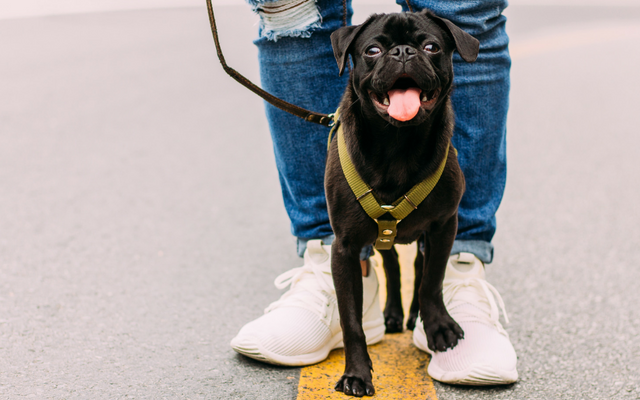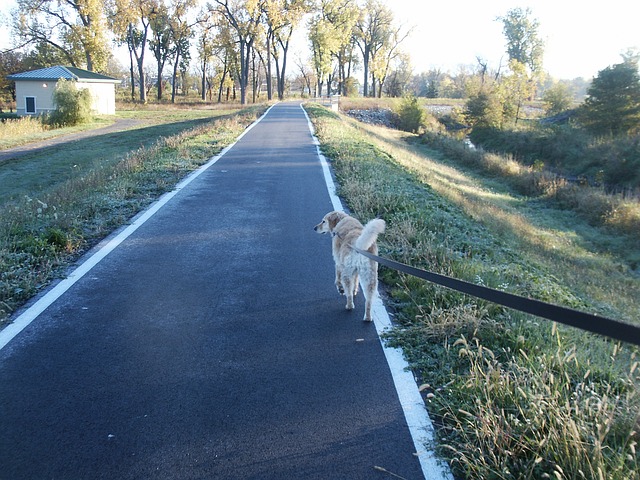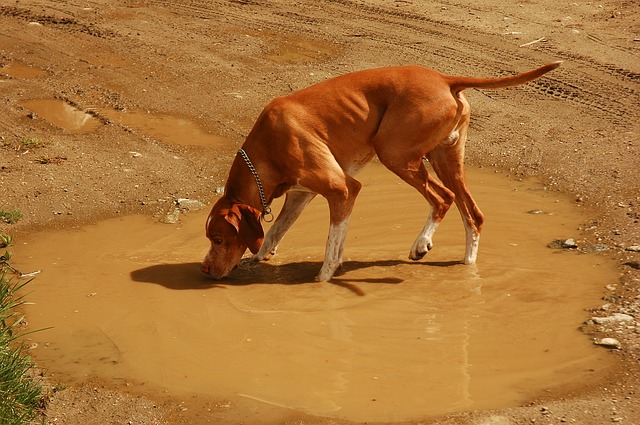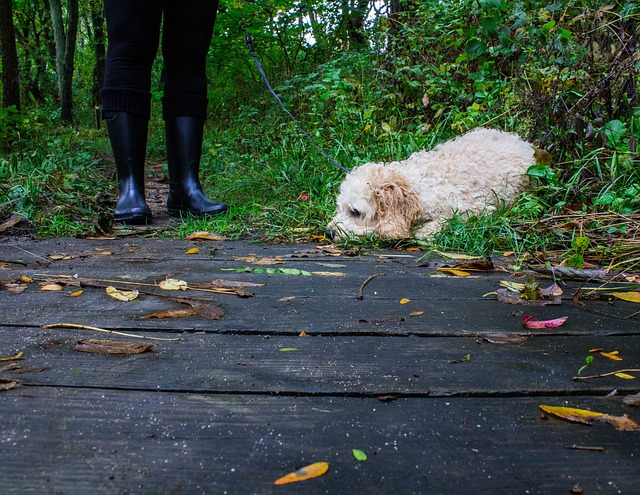
Whether it’s long treks through the neighborhood or short strolls in the park, walking the dog is a part of every pup parent’s routine. It’s good for your health and happiness, and it’s probably your dog’s favorite part of the day. You should enjoy the opportunity to bond with your favorite furry family member, but as your dog’s protector, it’s your job to be on the lookout for potential threats. Unexpected hazards lurk near suburban sidewalks, rural country roads, and city streets. As long as you’re aware of these eight dangers, you and your pup can walk with confidence.

#1 – Litter
Candy wrappers, fast food containers, illegal substances—there’s no telling what kind of trash and debris you’ll find discarded during your walk. Dogs are scavengers by nature, so don’t be surprised when your pup pulls on the leash to get a taste of whatever they can find near the road .
If you walk through a park, there’s the added danger of your dog sniffing out things like discarded chicken bones, grease from a grill, or unidentifiable scraps of someone’s picnic. All of these things can make your dog sick or get stuck in their throat. Always scan the ground for harmful litter, and it’s also a good idea to teach your dog the “leave it” and “drop it” commands in case they see something before you do.
#2 – Dog Poop
Responsible pet parents always bend down to pick up the poop, but unfortunately, not everyone is as considerate. Eating poop is a relatively normal behavior for dogs, but eating random feces found near the sidewalk is a serious health hazard. Dogs end up ingesting poop that’s riddled with parasites and diseases.
If your pup has a penchant for eating poop, you’ll have to be on high alert when walking in neighborhoods and parks with a lot of canine visitors. Dogs that already consider poop to be an acceptable treat won’t hesitate to sniff it out and take a bite. Pay attention to the ground while you’re walking so you can steer your poop eater away from unsanitary sidewalk snacks.

#3 – Sun
You love your long summer walks, but too much sunshine can be a bad thing. Dogs get sunburn just like humans do, but few people take the time to apply doggy sunscreen. Dogs with light fur and pink skin are most at risk, and it’s important to apply a dog-friendly sunscreen to areas where their fur is thin. A lot of dogs end up with bright red snouts because of too much time in the sun.
Besides sunburn, there’s also the risk of your dog burning their paw pads on hot pavement. A good rule to follow is if the ground is too hot for you to walk barefoot, it’s too hot for your dog. A third sun-related concern is heatstroke. Your dog loves exercising, but they’re also wearing a fur coat in the middle of summer. They’re more susceptible to heat than you are, and if they get too hot, their life is in danger. It’s best to walk your dog early in the morning and in the evening when the summer sun isn’t as intense.
#4 – Water
Your pup thinks puddles, ponds, and creeks are great places to quench their thirst, but vets advise against it. ASPCA warns pet owners that stagnant water sources are often breeding grounds for mosquitoes that transmit heartworm. Seemingly clean water can also contain harmful parasites like giardia and bacterial diseases like leptosporosis.
If it rained recently, there’s also the chance of puddles containing harmful chemicals from pesticides washing off nearby lawns or manure from neighboring farms. To be safe, don’t let your dog drink from random water sources. It’s a better plan to either carry your own water supply or wait until you get home to let your dog drink.

#5 – Pesticides and Rodenticides
Pesticides are common in almost all areas where humans live. They’re good at keeping bugs out of yards, agricultural fields, flower gardens, and buildings, but they’re not safe for pets. If your dog rolls around on a recently treated lawn, they expose themselves to harmful chemicals. Most public parks and sidewalks are safe, but you can’t always tell which patches of grass are safe and which are covered in chemicals. If you’re not sure, it’s best to err on the side of caution.
Besides pesticides, dogs also get sick from poison set out to kill mice and rats. These usually look like blocks of bait put out near building foundations and under bushes. If your dog gets into one, take them to the vet right away.
#6 – Wild Animals
Depending on where you live, you could encounter anything from squirrels to black bears while walking down your road. No matter the animal—or the size of their teeth—it’s important for you and your dog to respect local wildlife. Dogs with high prey drives will want to chase every furry critter they see, and it’s your job to hold the leash tight (or better yet, use these tips to control their predatory instincts), to keep both your dog and their quarry safe.
For small dogs, there’s also the added risk of wild animal attacks. Small dogs are seen as easy targets, and hungry predators have been known to stalk small dogs on walks. Large birds of prey, coyotes, and mountain lions are all wild animals worth worrying about. You can help protect your pup by outfitting them with a Preadator Vest that both deters attacks and protects against bites.

#7 – Toxic Plants
There’s a long list of plants that are toxic to dogs. If your pup is the kind that likes to stop and sniff the flowers, they could accidentally (or on purpose) ingest a poisonous plant while out on a walk. The best protection plan is to familiarize yourself with common plants that grow in your area that are also dangerous for dogs. Tulips, lilies, azaleas, sago palms, and hydrangeas are only a few examples.
Some plants instantly make dogs sicks, but others work more slowly. You might not realize what’s happening until it’s too late. If your dog vomits, acts dizzy, or shows other signs of sickness after romping through a field of flowers, head to your vet immediately.
#8 – Unleashed Pets
There are too many variables to account for when you see an unleashed dog on your walk. There’s the chance the dog is friendly and wanting to politely say hello, but don’t rule out the possibility that they’re aggressive toward other dogs or people. And even if your dog generally likes other canines, being leashed while a strange dog approaches them could make them feel threatened.
Regardless of who starts it, breaking up a dog fight on the side of the road is not how you want to spend your walk. Stay alert during your walk and turn the other way if you see an unleashed pet. If you’re concerned for the other dog’s well-being, go home to drop off your pet before you move in to help a potential stray.
via Whisker Therapy